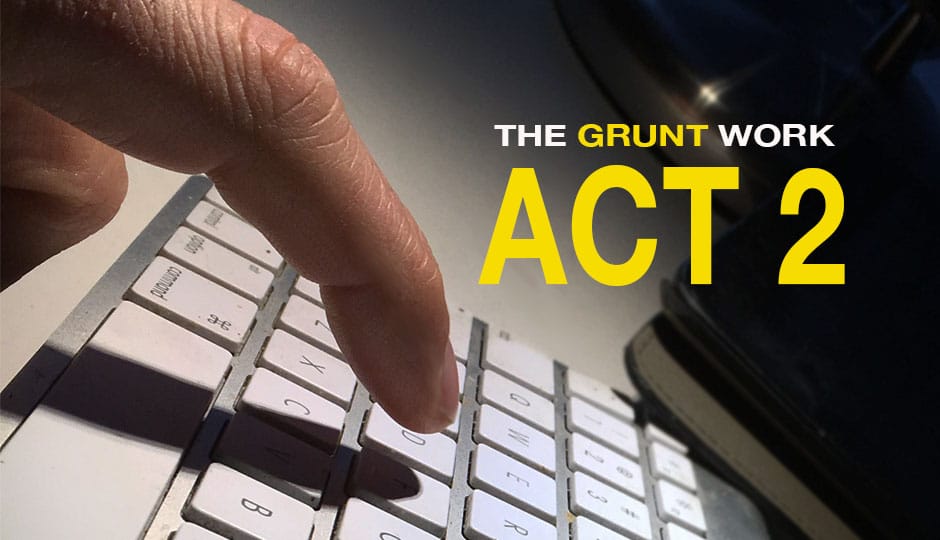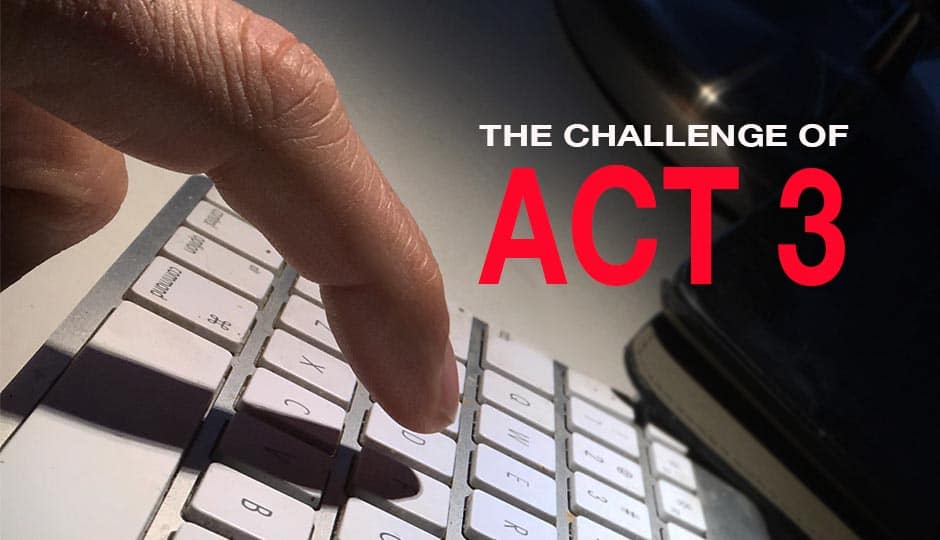In a three-act screenplay Act One needs to accomplish a lot in very little time, with a “call to action” that moves the main character into the story’s spine.
By Charles Deemer, Edited by Stavros C. Stavrides
The Hook
The first challenge of the screenwriter is to get and hold our attention. I give my university students “the popcorn test.” It goes this way.
A couple sits down in a movie house the moment before the feature begins. The woman leans to the man and says, “We should have gotten popcorn.” The feature begins. The man looks at the screen. Can he go out and buy popcorn or is he so riveted by what’s happening on the screen that he stays put?
Your job, as a screenwriter, is to make sure no one can leave to buy popcorn.
In ‘Jurassic Park’, we open with a guard being killed by some sort of strange, caged creature. What is going on? We want to know. We are hooked.
Look at the first minute or several minutes of any movie — and then ask yourself, “Why am I watching this?” If you have an answer, the movie has a good hook. So should you.
The Complication
With the attention of the audience “hooked” to our opening, it’s time to move quickly to the spine of our story. What I call “the complication” is an important story event that begins this movement.
In ‘Jurassic Park’ the complication is the scene following the guard’s death when a lawyer reveals that the accident may delay the opening of the theme park of cloned prehistoric animals.
What is needed is the endorsement of a respected scientist that the park is safe, despite the accident. Notice how this moves us to the participation of the main character, the scientist.
Sometimes the complication involves the protagonist directly, as in ‘The Graduate’. Here we have a “soft hook” – a quirky main character whom we meet at the film’s opening moment.
Who is this guy? At the complication, Mrs. Robinson makes her first move on him. This request for a ride home, and later a more explicit proposition, propels us to the focus of the story, which is their affair and its consequences.
This post is a support article for the chapter “Screenwriting” in
Cyber Film School’s Multi-Touch Filmmaking Textbook.
The Call To Action
Perhaps the most important moment in the structure of Act One is the “call to action.” This is an action by the main character that moves him or her directly into the spine of the story, that dramatic area of focus that locates what the story is essentially going to be about.
In Jurassic Park, the scientist is given such a good deal to check out the theme park that he can’t refuse. He says “Yes,” and the story reveals its focus. In The Graduate, Benjamin hems and haws about the possibility of an affair with Mrs. Robinson and finally, in his bungling way, says “Yes.” Again, the story finds its focus.
A call to action is usually the protagonist saying “Yes”, doing an action that is affirmative, to a question that moves us into the central focus of the story.
End of Act One Plot Point
Once “in the story,” the hero reaches a point where normal life (how the protagonist lived before the story) gives way to extra-normal life, the “new life” in the story.
Mythic critics call this the move from the ordinary to the extraordinary worlds. The scientist moves from his usual life on a dig to the extraordinary experience of being among cloned prehistoric animals. Benjamin moves from uncertain, bored college graduate to a man having an affair with a married woman and friend of his family.
The journey of the main character is from ordinary life into the highly charged, unusual experiences represented by the story. The story has begun in earnest.
Summary
Let’s look at the rhythms of Act One again, with another example.
- The Hook. We get the audience’s attention. In Shakespeare in Love, a debtor is being tortured. He promises the pay off the debt with monies from Shakespeare’s new play.
- The Complication. Time to move toward the focus of the story. But Shakespeare has writer’s block. He needs a female muse.
- The Call to Action. The hero says, “Yes.” First, Shakespeare says, “Yes” to the wrong woman – he catches her in bed with someone else. Then he meets Viola at a dance. He wants her. He starts writing like crazy, even writing her a sonnet. We have found the focus, their love story and the play this energy creates.
- Plot Point. The hero moves from the ordinary to the extraordinary world. Will puts his new play in rehearsal and casts the disguised Viola. He’s falling in love with Viola and impressed with the actor at the same time, not realizing they are the same. He is at the top of his powers.
The life of this play is his new world, and in it, he will meet all the coming surprises of the story.
These are the rhythms of Act One, all of which must be established in 20 to 30 pages.
Let’s move on to Act Two, which most screenwriters believe is the most difficult to write.
Make Cinema Your Language
Cinema is a language we all understand, but not everyone ‘speaks’ it–directors do.
This interactive, self-guided textbook is a director’s toolbox, made for Apple Books.
Embrace a solid foundation with a future-proof, classic combo of theory, technique, history, and critical thinking.
Gain practical, adaptable creative skills and insight that transcend technological changes, be it a camera, mobile device, or AI.




